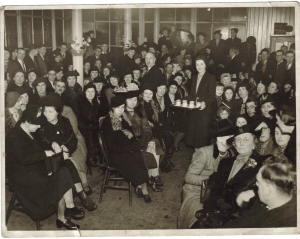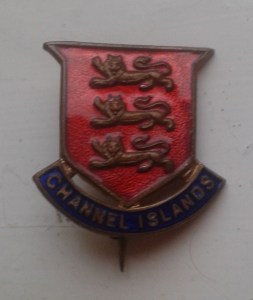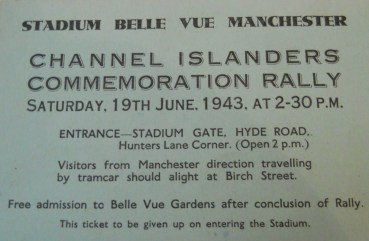I have been interviewing Second World War evacuees since 2008 and my latest book, Britain’s Wartime Evacuees, took 8 years of research. You can find it at https://www.amazon.co.uk/gp/product/1848324413?ie=UTF8&camp=1634&creativeASIN=1848324413&linkCode=xm2&tag=guerevacoralh-21
I have spent years examining local archives for documents which provide details of the wartime presence of evacuees. One aspect I stumbled upon was that, in some areas which contained a moderate number of evacuees, ‘evacuee social clubs’ were set up. These clubs provided emotional support for adult evacuees – young mothers and teachers – who were far away from home. They also provided social activities for both adults and child evacuees.
So far, my research shows that the largest group of evacuees to form such ‘evacuee clubs’ in Britain were the 23,000 Channel Islanders who came here from Guernsey, Jersey, Alderney and Sark. Around 90 clubs were established, all over Britain, ranging from Scotland to Southampton and the evacuees called them ‘Channel Island Societies’. These societies collected membership subscriptions, raised funds, and organised regular meetings and social events. Societies in Lancashire and Cheshire organised outings to Belle Vue Pleasure Grounds in Manchester. In addition, many societies established Welfare Committees to obtain grants, legal advice and clothing for their members. At Christmas the societies organised tea parties for the children, often in conjunction with the local council.
This photograph was taken at the first Stockport meeting
The regular meetings were very important to the evacuees as they were able to talk with those who actually understood what they were going through. One evacuee wrote,
“This society is doing the very important war work of serving as an outpost of our beloved Islands, and a rallying point to which our members can bring their news and their troubles. As comrades bound together, we bear one another’s burdens and share one another’s joys.”
Mrs Lowe shared a house with her children and father in law, and wrote in her diary,
“My father in law is driving me to distraction. Nothing is good enough for him, and I only hold my tongue for the sake of my poor husband who is trapped in Guernsey. Please God we return home soon and my father in law can move back into his own cottage! The Society meetings are my only break from him!”
Many adults also felt that it would be useful to be actually identified as ‘Channel Island evacuees’ as they went about their daily business in England. Mrs F Lucy wrote to the Channel Islands Review in July 1942, asking
“Is it feasible for us to have a badge? A lady and I travelled together over 30 miles on the same bus and never knew we were fellow Islanders until the end … if only we had worn a badge”
Several thousands badges were produced and I am very lucky to be given one of these rare badges by my friend, and Guernsey evacuee, Mrs Joan Ozanne. Even today, many Guernsey people wear a pin badge of the Guernsey flag when visiting friends and family in England.
Channel Islanders serving in the forces attended meetings whenever they could. Winifred West and her friend attended a meeting in Wolverhampton, travelling by train and trolley bus from their WAAF camp,
“We had a wonderful time, but when we came home and got on the trolley bus it broke down! Finally they got out another trolley bus for us … it was 10pm by the time we got to Walsall and there were no trains until 1-2am, now we were AWOL! There was nothing we could do, we had a meal at a Red Cross forces canteen. We didn’t get back to our camp until 3am and faced a very angry camp guard!”
Channel Island societies arranged events such as card games, raffles and dances. Lawrence Torode became Secretary of the Bury (Lancashire) Society at the age of 17, and recalls numerous tea dances and tea parties. However Clem Brehaut pointed out that, for the adult evacuees, ‘these meetings very often ended in tears, not knowing who would meet again, due to air raids and bombings’.
Arguably the most influential society was the Stockport and District Channel Island Society, formed in January 1941. Five miles south of Manchester’s city centre, the Society had around 1,000 members. The Stockport Advertiser described their first meeting,
“250 evacuees attended, and folk who have long been separated from their homes and friends were eager for news; the most popular speakers were those who were able to give news of home, or of friends who are now scattered up and down the land.”
Mrs Ruth Alexandre was on the society’s committee, and her diary describes numerous visits to evacuees, to discover their needs. She often spent the mornings investigating welfare cases, and the afternoons sorting through clothing donations.
However, the Stockport society’s main achievement was its newsletter, the Channel Islands Monthly Review. In May 1941 a 4 page news sheet was produced, which by 1944 had grown in size to 24 pages. The magazine was originally produced for Stockport’s members only, but other societies began to order copies, and soon each print run was for five thousand copies. The August 1940 issue of the magazine included an Editorial, a letters page, Channel Island songs and poetry, and details of the activities of other societies. The ‘Enquiries’ page contained messages from evacuees who were trying to locate friends and family.
There was also news of Islanders who were serving in the Forces, and of those interned in German camps. A section was devoted to the most important content, the rare 25 word Red Cross messages recently received from the Channel Islands. The fact that these often intimate messages were printed for thousands of others to read shows that there was a deep hunger for news about life in their occupied homeland. The Review was passed from one evacuee to another, (not all could afford to purchase a copy) then sent overseas to be read by islanders serving in the Forces. One issue stated, ‘Imagine the pleasure of a Channel Islander in Gibraltar or Egypt, reading familiar names and places.’
Leading local dignitaries frequently attended Channel Island society meetings and the Mayor of Bolton advised Islanders, ‘When peace returns, the Islands will be invaded by Lancashire holidaymakers who, having heard so much of the islands, are curious to see them for themselves!’ Lady Astor distributed Christmas presents to children at several Channel Island society parties. A Channel Island Rally held at Belle Vue, Manchester, in 1943 was attended by 6,000 evacuees and the Deputy Mayor of Manchester.
TO FIND OUT MORE ABOUT MY WW2 EVACUEE RESEARCH AND BOOKS, GO TO
http://www.amazon.co.uk/Gillian-Mawson/e/B008MWQ0IE/ref=dp_byline_cont_book_1
My Guernsey evacution blog can be found at:
https://guernseyevacuees.wordpress.com/evacuation/
CONTACT ME PRIVATELY HERE:



